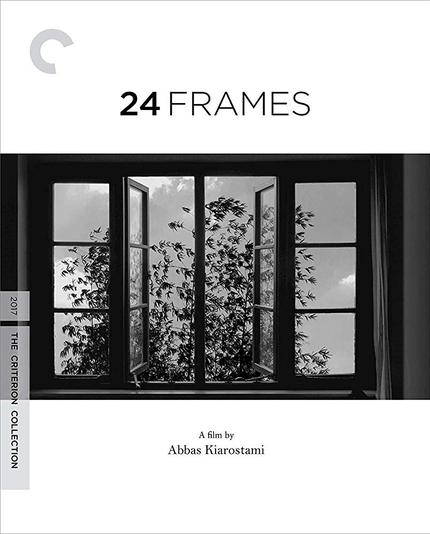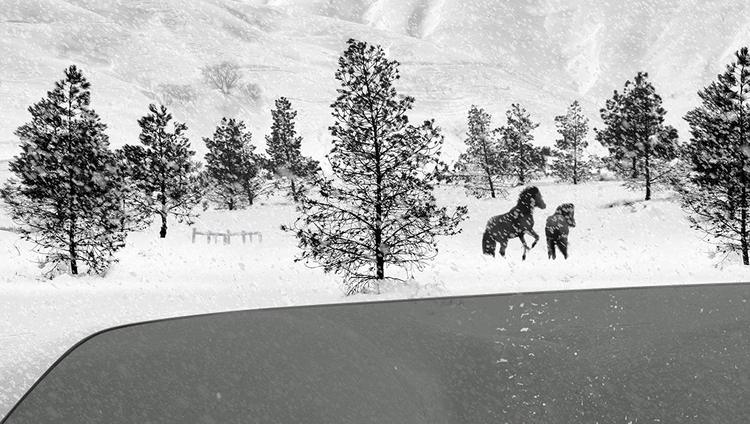Blu-ray Review: 24 FRAMES Mischievously, Compellingly Lulls to the End of Abbas Kiarostami's Life, Career
Criterion releases the final film by the late, great Iranian filmmaker.

Though not always a popular talent in his homeland, or even abroad, it’s fair to assess Kiarostami as a kind of “filmmaker’s filmmaker”.
Jean-Luc Godard has said, "Film begins with D.W. Griffith and ends with Abbas Kiarostami." Godard is always good for hyperbolic provocation, it’s true. But before dismissing or minimizing this statement, consider the words of another iconoclastic filmmaker.
According to Martin Scorsese, "Kiarostami represents the highest level of artistry in the cinema." When these words are quoted in front of Kiarostami, he winces most charmingly. "This admiration is perhaps more appropriate after I am dead," he says.
Sadly, here we are. On July 4, 2016, at age 76, Abbas Kiarostami merged with the infinite. Sharply following a collective moment of mournful silence on behalf of the global film community, IndieWire film critic Eric Kohn, on his weekly “Screen Talk” podcast, pronounced Kiarostami as having instantly passed from the realm of moral, living directors into the rarified pantheon of our most monumental, etched-in-stone auteurs. It was a large statement to digest so soon.
Though there we were, only days following Kiarostami’s sudden (to us) passing, unable to disagree in the slightest. His decades-long and world-spanning body of work, much of which is only now starting to become available to the Western world, will indeed live on.
It turns out that Kiarostami was working right up to the end. Although confined to a hospital bed, the director was able to continue pecking away at his final film, the completely unconventional 24 Frames. Filmmakers will immediately recognize the title as the rate per second which images are captured in the making of motion pictures. For someone so keenly devoted to formulating ways to continually strip down the cinematic medium, such a title for Kiarostami’s farewell work can’t help but feel just right.
Feel free to have an opinion as to whether or not 24 Frames itself rightly qualifies as cinema versus something more akin to an art gallery instillation. Further complicating any such decision is the project’s creative origin as the latter, an intended fine art installation. Nothing more than a series of twenty-four slyly manipulated-to-motion photos taken previously by the director himself (actually twenty-three photos and one famous painting) hanging onscreen for four and a half minutes each, 24 Frames is all about inviting deeply meditative engagement with the captured image. The mind will go where it goes, though along the way, the intentionality in the sequencing reinforces the decision to group these quiet (though not silent), dialogue-free images into this singular film emerges as appropriate.
Though the brief bonus features inform us that Kiarostami’s initial idea was to apply this technique to famous paintings for the duration of 24 Frames, he switched gears to manipulating his own still photographs. Though more was done with paintings, only one makes it into the final cut. (Unfortunately, no “outtake frames” are made available on this Blu-ray).
Without the actual photographs to reference, it’s impossible to discern which of their many twenty-four frames per second is the original. Is it the starting point, the finishing point, or somewhere in between? And like the books of the holy scripture, is there an ordained sanctification in the order in which they’re placed within the body of the whole?

24 Frames opens on Pieter Bruegel’s 1565 winter-scape painting, The Hunters in the Snow. Though serene at a glance, Bruegel the senior’s work actually depicts a grasp at communal normalcy in what’s been cited as the coldest decade of the frigid “Little Ice Age”, which occurred roughly between 1300 and 1850.
The significance of Kiarostami opting to begin what he likely knew to be his final work with this particular painting cannot be overlooked, as it signals the end of a long and difficult journey; the approach to a better place. Slowly, certain elements of the frame come to life: some birds (but not all), a dog, a few leaves. The painting remains the painting, at least in spirit; it’s the life within the frozen moment- what happens in and around it- that interests Kiarostami.
From there, the film switches gears in terms of source material. The remaining twenty-three images are photographs. Almost all nature shots, various landscapes, captured perhaps on the fly, perhaps staged, by Kiarostami. They are well composed and, for the most part, in silvery greyscale. Sometimes though, a car window or a window shade or a shutter will raise or lower. Occasionally, shots ring out or an animal goes nuts, rattling the meditative vibe.
Other times, it’s the nearly undetectable subtly of something simply not right. Snow flurries blow one direct while branches blow the opposite way. In cases such as that, one might need four and a half minutes to get at just what it is that’s unsettling. It’s Kiarostami’s impishness, a spark that arguably saves 24 Frames from being wrongly dismissed as “screensaver cinema”. FilmComment.com recently described the great, departed actor Bruno Ganz as a “mischievous angel”. Though a reference to Ganz’s go-to film, Wim Wenders’ Wings of Desire, the same description could be applied to Abbas Kiarostami.
Through a process of staging and recording matching elements, 24 Frames is uniquely realized. Crafted on a laptop by just a few people, and completed by the filmmaker’s son following his death, there is a palpable finality about the thing. As we grow ever closer to the end, with each frame announcing itself numerically, the pangs of existential dread and curiosity grow stronger and stronger. What will be the final shot, the final frame, of the final Kiarostami movie be? What will be Frame 24? Fear not, faithful cinephile, it’s a perfect choice. Simple; perfect.
Not a masterpiece or even a movie, per se, 24 Frames is nonetheless a rightful coda in the career of a cinema master. Excepting perhaps the original shoot of the images themselves, no actual film was used in the rendering of this project. Yet, the persistence of life in this persistence of vision experiment is a reflective end to its creator’s journey, one that brought us inward even as he daringly stepped back. And in one twenty-forth of a second, everything can change; the mystery can be made apparent.
(See also Dustin Chang's original review of the film.)






